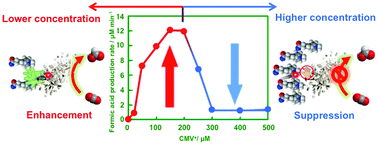Abnormal co-enzymatic behavior of a one-electron reduced bipyridinium salt with a carbamoyl group on the catalytic activity of CO2 reduction by formate dehydrogenase
Abstract
One-electron reduced bipyridinium salt (BP˙) acts as a co-enzyme for formate dehydrogenase (FDH) from Candida boidinii in CO2 reduction to formic acid. By using BP˙ with a carbamoyl group (CMV˙), the CO2 reduction catalytic activity of FDH was improved compared with those of other BP˙s. Moreover, CMV˙ did not act as a co-enzyme for FDH in the presence of more than 20 times higher concentration of CMV˙ against FDH. This is the first report of BP˙ with the abnormal co-enzymatic behavior on the catalytic activity of CO2 reduction by FDH.



 Please wait while we load your content...
Please wait while we load your content...